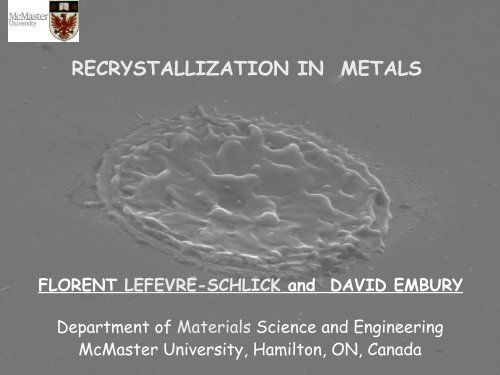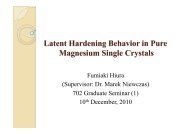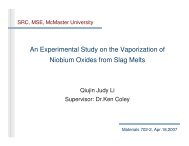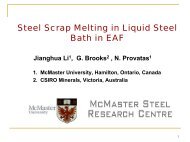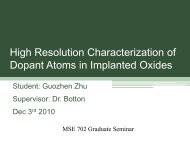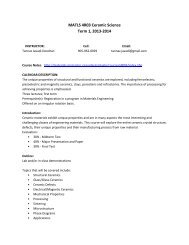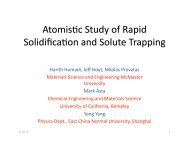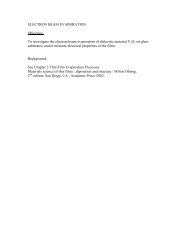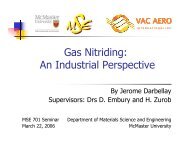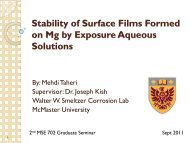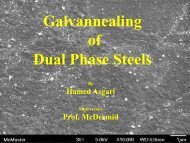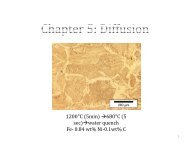recrystallization in metals - Course Notes - McMaster University
recrystallization in metals - Course Notes - McMaster University
recrystallization in metals - Course Notes - McMaster University
Create successful ePaper yourself
Turn your PDF publications into a flip-book with our unique Google optimized e-Paper software.
RECRYSTALLIZATION IN METALS<br />
FLORENT LEFEVRE-SCHLICK and DAVID EMBURY<br />
Department of Materials Science and Eng<strong>in</strong>eer<strong>in</strong>g<br />
<strong>McMaster</strong> <strong>University</strong>, Hamilton, ON, Canada<br />
1
OUTLINE<br />
Recrystallization<br />
What is it<br />
How is it usually treated<br />
Importance of local misorientation/stra<strong>in</strong> gradients on “nucleation”<br />
First stages of <strong>recrystallization</strong>; how can we <strong>in</strong>vestigate the “nucleation”<br />
Rapid heat treatments<br />
What are they<br />
What can we expect from them<br />
Recrystallization <strong>in</strong> <strong>metals</strong><br />
Model<strong>in</strong>g<br />
Conclusions-Future work<br />
2
Recrystallization<br />
What is it<br />
Fe<br />
E =E stored<br />
=~100J/mol<br />
Deformation<br />
Heat<br />
Recrystallization<br />
(development of new stra<strong>in</strong> free gra<strong>in</strong>s)<br />
Recovery<br />
(rearrangement of dislocations <strong>in</strong> sub gra<strong>in</strong>s)<br />
3
Recrystallization<br />
HOW DOES RECRYSTALLIZATION START<br />
“nucleation”<br />
Coalescence and growth of subgra<strong>in</strong>s<br />
∆Θ 3<br />
∆Θ 4<br />
∆Θ 3<br />
∆Θ 4<br />
∆Θ 1<br />
∆Θ 1<br />
∆Θ 2<br />
Stra<strong>in</strong> Induced<br />
Boundary Migration<br />
Migration of a boundary<br />
Θ 1<br />
Θ 2<br />
Θ 1<br />
E 1 > E 2<br />
Θ 2<br />
Θ 2<br />
In simple systems: small number of “nuclei” lead to recrystallized gra<strong>in</strong>s<br />
4
Recrystallization<br />
Improv<strong>in</strong>g the mechanical properties of materials<br />
σY (MPa)<br />
7000<br />
6000<br />
5000<br />
4000<br />
3000<br />
2000<br />
1000<br />
Cu<br />
Fe<br />
Al<br />
Gra<strong>in</strong> ref<strong>in</strong>ement strengthen<strong>in</strong>g<br />
0<br />
0 2 4 6 8 10<br />
d -1/2 (µm -1/2 )<br />
How does <strong>recrystallization</strong> proceed<br />
How to control <strong>recrystallization</strong><br />
How to achieve an important gra<strong>in</strong> ref<strong>in</strong>ement<br />
Can we control more than just the scale<br />
5
Recrystallization<br />
Johnson, Mehl, Avrami, Kolmogorov approach<br />
recrystallized fraction X<br />
X<br />
1<br />
0<br />
n<br />
= 1 − exp( −Bt<br />
)<br />
time<br />
Random distribution of nucleation sites<br />
Constant rate of nucleation and growth n=4<br />
Site saturation n=3<br />
6
Recrystallization<br />
Johnson, Mehl, Avrami, Kolmogorov approach<br />
Is n mislead<strong>in</strong>g<br />
Site saturation 3d/2d/1d<br />
3/2/1<br />
Constant nucleation rate 3d/2d/1d<br />
4/3/2<br />
F<strong>in</strong>ed gra<strong>in</strong>ed Alum<strong>in</strong>ium, low stra<strong>in</strong><br />
4<br />
Alum<strong>in</strong>ium+ small amount of copper, 40% cold<br />
rolled<br />
Fe-Mn-C<br />
1.7<br />
Recrystallization<br />
“NUCLEATION” OF RECRYSTALLIZATION<br />
Large orientation gradient<br />
(transition bands)<br />
Stra<strong>in</strong> heterogeneities<br />
(shear bands)<br />
Fe-Si system<br />
Cu<br />
Hu et al. (1966) Adcock et al. (1922)<br />
8
Recrystallization<br />
“NUCLEATION” OF RECRYSTALLIZATION<br />
Particle Stimulated Nucleation<br />
Oxide <strong>in</strong>clusions <strong>in</strong> Fe Al-Si system Cluster of SiO 2<br />
<strong>in</strong> Ni<br />
Leslie et al. (1963) Humphreys et al. (1977)<br />
Recrystallization orig<strong>in</strong>ates at pre-exist<strong>in</strong>g subgra<strong>in</strong>s with<strong>in</strong> the deformation zone<br />
Nucleation is affected by particle size and particle distribution<br />
9
Recrystallization<br />
INVESTIGATING THE “NUCLEATION” EVENT<br />
Inject<strong>in</strong>g nucleation sites to <strong>in</strong>crease N:<br />
• Local misorientation (tw<strong>in</strong>s)<br />
• Local stra<strong>in</strong> gradient (high deformation)<br />
Imped<strong>in</strong>g growth of recrystallized gra<strong>in</strong>s<br />
• Rapid heat treatments<br />
o<br />
10
Rapid heat treatments<br />
What are rapid heat treatments<br />
•“Slow” heat treatment<br />
(salt bath)<br />
•“Rapid” heat treatment<br />
(spot weld<strong>in</strong>g mach<strong>in</strong>e)<br />
•“Ultra-fast” heat treatment<br />
(pulsed laser)<br />
T<br />
T<br />
T<br />
seconds<br />
mseconds<br />
time<br />
time<br />
nano/pico/femtoseconds<br />
time<br />
11
Salt bath<br />
“Slow” heat treatment: Salt bath<br />
Tim e/Tem perature profile dur<strong>in</strong>g salt bath<br />
heat treatm ent<br />
700<br />
Duration of the heat<br />
treatment: 5 seconds.<br />
Temperature range: 500 o C<br />
to 650 o C.<br />
Heat<strong>in</strong>g rate ~300C/sec<br />
Cool<strong>in</strong>g rate ~1000C/sec<br />
Tem perature (C)<br />
600<br />
500<br />
400<br />
300<br />
200<br />
100<br />
0<br />
0 5 10 15<br />
Time (sec)<br />
12
Salt bath<br />
“NUCLEATION” IN IRON<br />
Fe deformed by impact at 77K<br />
Production of deformation tw<strong>in</strong>s to promote a variety of potential<br />
nucleation sites for <strong>recrystallization</strong>, either at tw<strong>in</strong>/gra<strong>in</strong><br />
boundary or tw<strong>in</strong>/tw<strong>in</strong> <strong>in</strong>tersections<br />
(1-11)<br />
2-22<br />
(-2-11)<br />
-2-11<br />
-200<br />
21-1<br />
01-1 -21-1<br />
50 µm 4 µm B=[011]<br />
Tw<strong>in</strong>n<strong>in</strong>g plane {112}<br />
Shear direction 111<br />
gra<strong>in</strong><br />
tw<strong>in</strong><br />
13
Salt bath<br />
“NUCLEATION” IN IRON<br />
5 seconds at 500 o C<br />
Kikuchi patterns of the parent gra<strong>in</strong>, a tw<strong>in</strong> and a cell<br />
of dislocations. Shift of about 0.5 deg <strong>in</strong> the ZA<br />
between the gra<strong>in</strong> (green circle) and the cell (red<br />
circle).<br />
0-11<br />
ZA=[133]<br />
-110<br />
-310<br />
-301<br />
0-31<br />
22-2 21-1<br />
21-1<br />
200<br />
ZA=[011]<br />
12-1 -301<br />
ZA=[113]<br />
-110<br />
-110<br />
BF images of a nuclei<br />
along a deformed tw<strong>in</strong>.<br />
21-1<br />
0-31<br />
21-1<br />
0-31<br />
12-1<br />
-301<br />
12-1<br />
-301<br />
ZA=[113]<br />
14<br />
ZA=[113]
Salt bath<br />
“NUCLEATION” IN COPPER<br />
5 seconds at 250 o C<br />
Cu 60% cold rolled<br />
Cu ~ 2% recrystallized<br />
50 µm<br />
25 µm<br />
1 µm 4 µm<br />
No noticeable effect of anneal<strong>in</strong>g tw<strong>in</strong>s on nucleation<br />
15
Salt bath<br />
“NUCLEATION” IN STAINLESS STEEL<br />
45% cold rolled @ 77K<br />
Sta<strong>in</strong>less steel 316L<br />
100µm<br />
Cooperation with X. Wang<br />
16
Salt bath<br />
“NUCLEATION” IN STAINLESS STEEL<br />
Sta<strong>in</strong>less steel 316L<br />
2 m<strong>in</strong> @ 950C<br />
25µm<br />
Average gra<strong>in</strong> size: 7µm<br />
17
Salt bath<br />
“NUCLEATION” IN STAINLESS STEEL<br />
2 m<strong>in</strong> @ 900C<br />
Sta<strong>in</strong>less steel 316L<br />
25µm<br />
Average gra<strong>in</strong> size: 5µm<br />
18
Salt bath<br />
“NUCLEATION” IN STAINLESS STEEL<br />
Sta<strong>in</strong>less steel 316L<br />
2 m<strong>in</strong> @ 850C<br />
25µm<br />
Average gra<strong>in</strong> size: 3µm<br />
19
Salt bath<br />
“NUCLEATION” IN STAINLESS STEEL<br />
Sta<strong>in</strong>less steel 316L<br />
1 m<strong>in</strong> @ 800C<br />
10µm<br />
Role of anneal<strong>in</strong>g, deformation tw<strong>in</strong>s and phases on nucleation and growth<br />
20
Salt bath<br />
“NUCLEATION” IN STAINLESS STEEL<br />
Sta<strong>in</strong>less steel 316L<br />
1 m<strong>in</strong> @ 800C<br />
BF image<br />
DF image<br />
(austenite + martensite)<br />
DF image (austenite)<br />
DF image (Tw<strong>in</strong>)<br />
F<strong>in</strong>e and complex deformed microstructure<br />
Over a range of possible grow<strong>in</strong>g gra<strong>in</strong>s, only a few seem to grow<br />
21
Salt bath<br />
RECRYSTALLIZATION AS A WAY TO CONTROL THE NATURE<br />
OF GRAIN BOUNDARIES<br />
Sta<strong>in</strong>less steel 316L, 2 m<strong>in</strong> @ 850C<br />
30%<br />
25µm<br />
0%<br />
10 o 20 o 30 o 40 o 50 o 60 o<br />
~30% of Σ 3<br />
boundaries<br />
(rotation 60 o , axis )<br />
22
Spot weld<strong>in</strong>g mach<strong>in</strong>e<br />
“RAPID” HEAT TREATMENT: SPOT WELDING MACHINE<br />
Electrode of Cu<br />
250 µm<br />
3mm<br />
Fe annealed (thickness = 500 µm)<br />
Fe 60% cold rolled (thickness = 200 µm)<br />
Pulse discharge width: 1 msec<br />
Energy output: 100 J to 1 J<br />
Estimated heat<strong>in</strong>g rate ~10 5 K/sec<br />
23
Spot weld<strong>in</strong>g mach<strong>in</strong>e<br />
PHASE TRANSITION IN IRON<br />
Melted zone<br />
40 J Heated zone 20 J<br />
50 µm 50 µm<br />
Ref<strong>in</strong>ement of the microstructure via phase transitions<br />
Distribution <strong>in</strong> gra<strong>in</strong> size from 40 µm down to less than 1 µm<br />
24
Spot weld<strong>in</strong>g mach<strong>in</strong>e<br />
RECRYSTALLIZATION AND PHASE TRANSITION IN IRON<br />
Fe 60% cold rolled<br />
40 J<br />
100 µm<br />
50 µm<br />
Ref<strong>in</strong>ement of the microstructure via phase transitions and <strong>recrystallization</strong><br />
Distribution <strong>in</strong> gra<strong>in</strong> size from 100 µm down to less than 1 µm<br />
25
Spot weld<strong>in</strong>g mach<strong>in</strong>e<br />
RECRYSTALLIZATION AND PHASE TRANSITION IN IRON<br />
Fe 60% cold rolled<br />
20 J<br />
50 µm<br />
Localized event along specific gra<strong>in</strong> boundaries<br />
26
Pulse lasers<br />
“ULTRA FAST” HEAT TREATMENT: PULSE LASER IRRADIATION<br />
(nano/pico/femtosecond)<br />
Laser pulse:<br />
Energy (nJ to µJ)<br />
Time (fsec to nsec)<br />
Beam size (µm to mm)<br />
~100 nm<br />
to mm<br />
Small volume on the surface<br />
Rapid heat<strong>in</strong>g and cool<strong>in</strong>g<br />
(10 4 to 10 12 K/sec)<br />
Increase <strong>in</strong> pressure (up to TPa)<br />
Shock wave.<br />
Cooperation with Preston/Haugen group<br />
27
Pulse lasers<br />
“ULTRA FAST” HEAT TREATMENT: PULSE LASER IRRADIATION<br />
(nano/pico/femtosecond)<br />
λ = 800 nm<br />
The beam has a Gaussian profile<br />
with a radius ω 0<br />
E 0<br />
: full energy pulse (~10 µJ)<br />
τ p<br />
: duration of the pulse (~ 10 nsec/ 100psec/ 150 fsec)<br />
φ: fluence or energy per unit area (J/cm 2 )<br />
φ th<br />
: threshold fluence (J/cm 2 )<br />
fluence required to transform the surface<br />
28
Pulse lasers<br />
WHY PULSED LASERS<br />
29
Pulse lasers<br />
SINGLE PULSE ABLATION OF FE<br />
E = 9.2 µJ<br />
E = 3.2 µJ<br />
10 µm<br />
10 µm<br />
E = 1.0 µJ<br />
E = 0.2 µJ<br />
5 µm<br />
5 µm<br />
What is the temperature profile<br />
How to characterise the irradiated volume<br />
30
Pulse lasers<br />
TEMPERATURE MEASUREMENT DEVICE<br />
2 mm<br />
2 mm 100 µm<br />
2 µm<br />
Plat<strong>in</strong>um<br />
25 nm<br />
SiO 2<br />
isolant layer<br />
resistor<br />
connector<br />
Si substrate<br />
Measur<strong>in</strong>g the changes <strong>in</strong> resistivity of Pt<br />
Summer work of B. Iqbar<br />
estimat<strong>in</strong>g the temperature<br />
31
Pulse lasers<br />
INSTRUMENTED INDENTATION<br />
Fe annealed, 1 gra<strong>in</strong><br />
Corrected harmonic contact stiffness: 1.10 6 N/m<br />
Load On Sample (mN)<br />
30<br />
L U<br />
Hardness (GPa)<br />
16<br />
Reduced Modulus (GPa)<br />
400<br />
14<br />
12<br />
300<br />
20<br />
10<br />
10<br />
8<br />
6<br />
1<br />
2<br />
3<br />
4<br />
5<br />
[6]<br />
200<br />
1<br />
2<br />
M I<br />
3 H<br />
4N<br />
5<br />
[6]<br />
4<br />
2<br />
HD E<br />
0 M H I<br />
0<br />
N<br />
200 400 600 800 1000 1200<br />
Displacement Into Surface (nm)<br />
Fe annealed, 3 different gra<strong>in</strong>s<br />
M<br />
N HI<br />
0 200 400 600 800 1000<br />
Displacement Into Surface (nm)<br />
100<br />
0<br />
200 400 600 800 1000 1200<br />
Displacement Into Surface (nm)<br />
Load On Sample (mN)<br />
Hardness (GPa)<br />
Reduced Modulus (GPa)<br />
40<br />
16<br />
400<br />
14<br />
30<br />
L<br />
U<br />
12<br />
300<br />
20<br />
10<br />
8<br />
6<br />
[2]<br />
3<br />
4<br />
200<br />
I<br />
M H<br />
N[2]<br />
3<br />
4<br />
10<br />
4<br />
100<br />
0<br />
EHD<br />
MN<br />
HI<br />
200 400 600 800 1000 1200<br />
Displacement Into Surface (nm)<br />
2<br />
0<br />
M N H I<br />
200 400 600 800 1000 1200<br />
Displacement Into Surface (nm)<br />
0<br />
32<br />
200 400 600 800 1000 1200<br />
Displacement Into Surface (nm)
Pulse lasers<br />
INSTRUMENTED INDENTATION<br />
12 11 10<br />
1 2 3<br />
Load On Sample (mN)<br />
7<br />
Hardness (GPa)<br />
20<br />
6<br />
5<br />
4<br />
3<br />
2<br />
1<br />
0 S<br />
-1<br />
LU<br />
MN<br />
H I<br />
EHD<br />
100 200 300 400<br />
1<br />
2<br />
3<br />
4<br />
5<br />
6<br />
7<br />
8<br />
[9]<br />
10<br />
11<br />
12<br />
18<br />
16<br />
14<br />
12<br />
10<br />
8<br />
6<br />
4<br />
2<br />
0<br />
-2<br />
M N H I<br />
100 200 300 400<br />
Displacement Into Surface (nm)<br />
1<br />
2<br />
3<br />
4<br />
5<br />
6<br />
7<br />
8<br />
[9]<br />
10<br />
11<br />
12<br />
Displacement Into Surface (nm)<br />
Soften<strong>in</strong>g of the deformed material<br />
Is there local melt<strong>in</strong>g/solidification or local heat<strong>in</strong>g<br />
33
Model<strong>in</strong>g<br />
ZUROB’S MODEL FOR RECRYSTALLIZATION<br />
Gra<strong>in</strong> II<br />
Gra<strong>in</strong> I<br />
SG<br />
Gra<strong>in</strong> II<br />
Gra<strong>in</strong> I<br />
nucleus<br />
G(<br />
t)<br />
><br />
2γ<br />
r(<br />
t)<br />
Needs <strong>in</strong>put on local misorientations<br />
34
CONCLUSIONS – FUTURE WORK<br />
Investigation of the first stage of <strong>recrystallization</strong> by:<br />
o Design<strong>in</strong>g microstructures to promote N<br />
o<br />
o Us<strong>in</strong>g rapid heat treatments to allow nucleation but not G<br />
Characterize the heat treatment <strong>in</strong> terms of time/temperature<br />
profile<br />
Characterize the “nucleation” event <strong>in</strong> terms of local<br />
misorientation, local stra<strong>in</strong> gradient (EBSD)<br />
Introduce the data on misorientation <strong>in</strong>to Zurob’s model<br />
o<br />
35


